
Sowing guidelines
Seed supplies of most native grasses are so limited that hand sowing of small plots followed by hand raking to cover the seed are very common methods of establishing small scale trials. Often, much larger scale trials would be preferred, but sufficient seed simply does not exist for many species and varieties and so there is no alternative.
The number of species with smooth seeds that will readily flow through a standard small seed box on agricultural sowing equipment is limited (see Species quick reference). Australian native grass seeds tend to clump together and clog up standard seed boxes. As a result, much effort has been expended in designing specialised equipment that will handle fluffy seeds or seeds with scabrid or twisted awns.
A further complication is that some species have specific requirements for successful germination in the field and for survival of the seedlings for successful recruitment. There have been many trials in which germination has been satisfactory but the seedlings have failed to survive to maturity. This highlights the importance of appropriate post-sowing management. The main obstacles to successful field establishment of native grasses for major climatic zones are shown in Table 5.2.
Table 5.2. Obstacles to the successful establishment of native grasses in the major climatic zones in southern Australia. (Source: Scholz, G. (1996). Practical Guide to Rangeland Revegetation in New South Wales: Using Native Grasses. Technical Report No. 33. Department of Land and Water Conservation)
| Rainfall regime characterised by: | > 500 mm reliable soil moisture | >350 mm reliable rainfall events | <250 mm unreliable rainfall |
|---|---|---|---|
| Establishment problems | Existing pasture and weed competition | Maintaining soil moisture | Harvesting and maintaining soil moisture |
| Methods to overcome limitations | Control existing pasture and weeds with spraying, cultivation | Reduce run-off; increase infiltration | Ponding water; controlling run-off; increase infiltration |
| Technology used | Band seeder; cultivator | Discing; pitting; press wheels | Ponding banks; contour furrows |
Below 500 mm annual rainfall the most critical factor is adequate soil moisture, but in higher rainfall areas, competition from annual and perennial weeds presents the most serious challenge to successful establishment of native grasses.
Generally two or more wet days will result in germination when other conditions, such as soil temperature are satisfactory. However it is the occurrence of follow-up rains, within 4–6 weeks of germination, that is required for successful establishment. The rate at which the soil surface dries out is critical not only for germination but also for establishment. Ideally, under cloudy conditions for several days, the soil surface will not dry out. Good follow-up rains will allow seedlings to develop adventitious (secondary roots) which can supply sufficient moisture for later seedling growth. More than any man-imposed management practice, it is the occurrence of these moisture conditions that will result in successful establishment.
Drilling
Conventional small seed boxes are satisfactory for sowing native grass seeds that are either naked caryopses (Caryopsis - The indehiscent fruit of most grasses with a single seed, the testa (seed coat) of which is fused with the pericarp (outer wall)) or are shed with smooth ancillary structures so that the dispersal units will flow easily. The seeds of these species generally germinate better when buried beneath the soil surface, but the number of species with these characteristics is relatively small. The dispersal units of some species (e.g. T. triandra and Austrodanthonia spp.) can be cleaned and separated into a form that can be sown using this equipment, although this is not the case for many other species of native grasses such as M. stipoides.
Specialised drilling equipment
Much ingenuity has been expended in the design of seedboxes for sowing fluffy or chaffy seeds by the farming community and a number have been manufactured on a small scale in farm or local workshops. The Landcare movement has provided much of the funding for these efforts but few of the seedboxes have been subjected to detailed study of their effectiveness in sowing untreated dispersal units of a range of difficult native grasses.
Specialised seed boxes
The B & S seed box was designed and built by B & S Industries, Oakey, Queensland specifically for 'fluffy' grass seeds. It includes an auger to move the seed across the bottom of the seed box to the metering box, a rotating spring (sweeper) to prevent the seed from bridging above the auger, a two, three or four bladed paddle to push the seed into the metering box and a spiked drum to meter the seed into the delivery tube (Picture 13). The delivery tube consists of 7 cm square rubber tube without internal obstructions that would cause the seed to bridge across the tube. The box can be mounted on a chisel plough and the seed delivered behind the tines. The seed delivery mechanisms are driven by a 12 V electric motor through a variable speed gearbox.
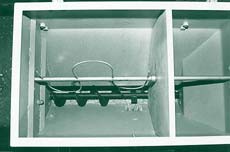
Picture 13 (right). Inside the B&S Industries seed box showing the rotating spring (sweeper) to prevent the seed bridging, the auger and paddle to deliver the seed to the metering box and the pegs on the cylinder of the seed metering device. The number of blades on the paddle was varied between two and four in different tests of this seed box. (Photograph R. Whalley)
While this machine was able to reliably sow M. stipoides seed without clogging up, the results were unsatisfactory because of uneven distribution of the seed within the drill rows. Various modifications were tried, but even distribution of seeds could not be achieved. However, it will sow an even row of seeds of many other species.
The 'Ausbox' is an all-purpose seed box that was built and manufactured by Richard Murphy, 'Wollondilly', Coonabarabran, NSW. It is especially designed to handle a wide range of slick and chaffy seeds. This box consists of a rotating spirally fluted roller that meters the seed into delivery tubes below the roller. This is an extremely simple but effective mechanism and the size of the flutes can be modified for boxes designed for different species (Picture 14).
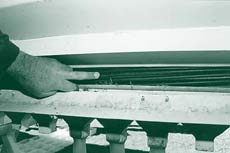
Picture 14 (right). Inside the Ausbox showing the fluted roller that delivers seed to an air seeder. (Photographer R. Whalley)
The Wiedemann/Kelly seed box (Figure 3) was designed to specifically deliver extremely chaffy seed at a consistent rate. The semi-circular seed box contains an auger agitator to keep the seed 'tumbling' and a pillar to maintain even 'density of seed' around a pickerwheel that drags the seed out of the box. This box has also been adapted to sow single rows of seed of Danthonia, Dichanthium, Themeda, Microlaena and Bothriochloa (Picture 15).
Figure 3 (below). The Wiedemann/Kelly pickerwheel seed box which meters fluffy seeds more evenly than conventional drum seeders.
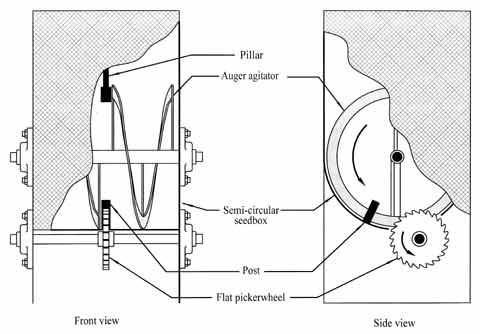
Picture 15. The Wiedemann/Kelly seed box adapted to sow single rows of native grasses, ideal for sowing seed production areas. (Photograph I. Cole)
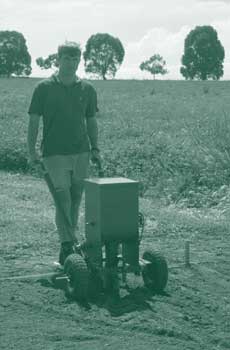
Crocodile seeder
The crocodile seeder originated in Queensland and has been successfully used to sow rough, unprepared sites. It consists of a steel drum with 'shovels' welded to the round surface (Picture 16 and Picture 17). When the drum is pulled on an angle, the shovels scoop out a divot of soil leaving a pitted surface with many small dams to trap and concentrate water. The steel drum is filled with seed, which falls through holes behind each shovel as it rotates, placing some seeds in each divot. The size of the divots is governed by the towing angle of the drum. It is a very robust machine and when pulled by a heavy 4WD or tractor can be used through light timber.
Picture 16. The 'Crocodile' seeder can be towed behind a 4WD vehicle, comprising a one pass seeding operation creating a water harvesting pit into which seed is placed. (Photograph C. Waters)
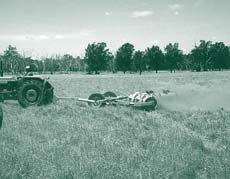
Picture 17. T. triandra successfully germinating in pits created by the 'Crocodile' seeder. (Photograph C. Waters)
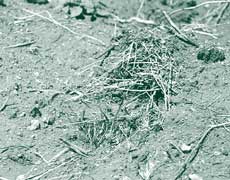
Other seeders
Additional ingenious devices for metering fluffy seeds are either available commercially or have been devised and built. These include rotating brushes to deliver seeds through suitable-sized holes in a plate, or belt seeders where the seeds are laid out by hand onto a V-shaped belt which rotates slowly over rollers, dropping the seeds into a furrow or onto the ground.
Sowing seeds of native grasses in drill rows is appropriate for the establishment of stands for seed production (see Section 6) but is not necessary for many purposes, such as for re-vegetation following mining. Many such situations involve sowing in areas where the substrate includes numerous rocks and stones and drilling equipment is easily damaged. A far better approach under these circumstances is to broadcast the seed and either cover lightly using chains or harrows, or simply rely on the ancillary structures to ensure that at least some seeds end up in safe sites. Seed broadcasting can be done using the seed boxes described above with the seed delivery tubes swinging free to broadcast the seed or using equipment specifically designed for the purpose.
A hydro/pneumatic seeder has been developed by John Stafford (Vegetation Management Services, Lenswood, South Australia). This machine attempts to reduce the weed problems associated with broadcasting seed by adopting the principles of row-crop management. This machine consists of three major components. A pilot spray enabling initial marking of strips, the seed drill which sows seed in a liquid polymer suspension, and a mid-row sprayer which allows inter-row weed control (Picture 18).
Picture 18 (right). The hydro/pneumatic seeder sowing Chloris truncata seed into open cuts made in the fallow strips that were created and maintained by a previous application of gylphosate. (Photograph J. Stafford)
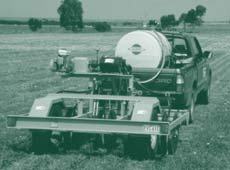
Seed blowers
Two seeders designed and built by NSW Agriculture, have been developed to provide low cost seeding equipment, which can easily be built in a farm workshop. The 'cranny seeder' (Picture 19) is designed to place seed in suitable micro-sites in the landscape. Placing seed into log mounds or fallen timber has been used as a successful establishment technique in low rainfall areas. These sites concentrate nutrients and moisture and protect new seedlings from drying out and stock grazing. The Cranny seeder is mounted on a 4WD vehicle and seed is blown through a hand-held wand into suitable micro-sites while driving through a paddock. A second seeder, the 'dribble seeder' (Picture 20) is designed to spread a small amount of seed over a large area. It is mounted on a 4WD vehicle or ATV and delivers a slow trickle of seed in front of a tyre as it travels through a paddock. The dribble seeder could be used when travelling through a paddock to muster or check stock, so would not be an extra job for a landholder. The effectiveness of these techniques has not been tested, but they are more likely to work in moist conditions.
Picture 19. The NSW Agriculture 'cranny seeder' blows seed into suitable micro-sites like log mounds to assist establishment and causes no soil disturbance. (Photograph C. Waters)
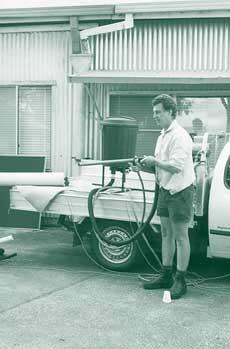
Picture 20. The NSW Agriculture 'dribble seeder' can be mounted on an ATV to sow seed over a large area while doing other jobs. This picture shows the paddle auger that slowly dribbles the seed. This technique has not yet been evaluated, however it is expected to be most successful under moist soil conditions. (Photograph C. Waters)
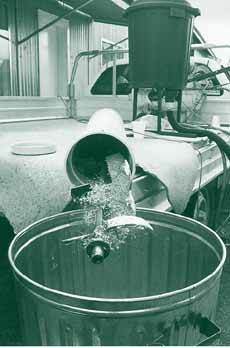
Air seeders
Gil Fletcher of Land Reclamation Services Pty Ltd in Emerald, Queensland, has designed and built an air seeder which will broadcast fluffy or awned native grass seeds without bridging or clogging (Picture 21). Essentially, this equipment consists of a conical hopper with a metering valve at the bottom comprising a disc on top of an open tube through which a suction is created using a sawdust extraction fan. Various stirring arms prevent the seed from bridging within the hopper. The seed-air mixture is then delivered through flexible hoses to a boom with three or four outlets so that the seed is delivered behind the machine. An additional hopper and more conventional seed metering device can be attached to deliver smooth seeds such as those of shrubs or trees, into the air stream. This equipment will also handle grass material containing a large quantity of straw provided it has been passed through a chaff cutter.
Picture 21. Air seeder designed and built by Gil Fletcher of Land Reclamation Services, Emerald, QLD. The petrol motor powers a sawdust extractor fan and a stirring disk and valve powered by a 12 V motor meter the seed from the bottom of the large hopper into the air stream. The smaller hopper on the right has a more conventional seed metering device, also powered by a 12 V electric motor to deliver smooth seed into the air stream. (Photograph D. Munnich)
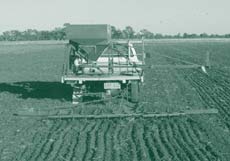
Another seeder that is suitable for cleared land has been built by Rosedale Engineering at Gulgong. The 'Germinator' uses components from broad-acre farming machinery and is designed to cultivate the seeding row, place the seed close to the surface and cover it with a press wheel. The seed is metered from an 'Ausbox' seed box and delivered to the tines with an air system. The Germinator has worked quite successfully, although some problems with seed blockages have occurred. Modifications have been made to the seeder by NSW Agriculture and DLWC which have improved its performance (Picture 22).
Picture 22. The 'Germinator', built by Rosedale Engineering at Gulgong, is a modified air seeder designed to direct drill native grass seed. The 'Ausbox' employs a fluted roller as an effective seed metering device. The air seeder system distributes the seed with minimal blockages and surface sowing boots place the seed at or very near the soil surface. (Photograph C. Waters)
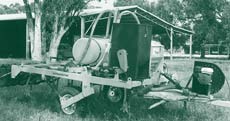
Hydromulching
Hydromulching involves putting seed, dye coloured wood pulp and perhaps some fertiliser into a water-filled tank and spraying the agitated mixture on top of the soil via a 50 mm diameter hose. Ideally, the mulch should be about 20 mm thick on the soil surface to provide a stable surface for seed germination and provide some control of the germination of small seeded weeds beneath it. The agitation of the cellulose fibre in the tank and the large diameter delivery tube mean that virtually any native grass seed can be evenly sown using this equipment (Picture 23).
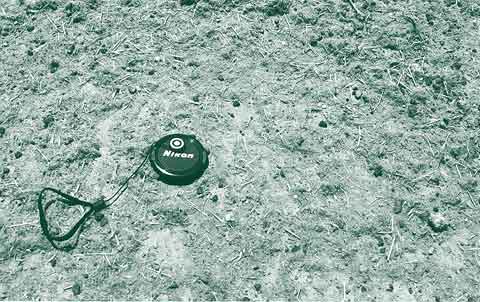
Picture 23 (above). Hydromulched area beside the Armidale Bypass eight days after treatment. Note the sparse cover of the mulch and the M. stipoides seeds. (Photograph R. Whalley)
Use of other mulches
Satisfactory emergence can be obtained by covering surface sown seed with a variety of mulches where a high-density stand is required. Mulch depths of about 20 mm are satisfactory for friable mulches, which do not impede the seedling emergence for relatively large seeded species such as M. stipoides. Thinner layers of mulch should be used for smaller seeded species.
The most satisfactory mulches appear to be mulched eucalypt, sheep manure or wood pulp as used in a hydromulcher. Because M. stipoides is more abundant on acid soils, mulches which tend to make the soil more acid are likely to give it and similar species a competitive advantage over weeds.
Forage harvesting and spreading
Harvesting the whole plant using either hand labour or a forage harvester when most of the seed is ripe and immediately spreading the harvested material on the site to be sown is a technique which has been found to be successful for some species, particularly T. triandra. A slightly different technique is to harvest groups of spikelets (Spikelet - Consists of one or more florets and is the basic unit of the inflorescence in grasses) of T. triandra using a suitably adjusted brush harvester and spread them directly on to the soil surface. This approach has been used successfully to replace serrated tussock (Nassella trichotoma) on the St. Albans campus of the Victorian University of Technology.
The procedure as used by the Native Grass Resources Group Inc. in South Australia, involves harvesting the whole T. triandra plants when the black awns of the fertile spikelets become apparent in December or January. The harvested material is immediately spread on the area to be planted and left for the next nine months. During this time, the dispersal units fall and the hygroscopically (Hygroscopic - Responds (twists or opens) to moisture changes) active awns (Awn - An elongated bristle-like appendage attached to the apex, back or base of the glume, lemma or palea) position the fertile spikelets in suitable microsites at or below the soil surface. In the following September/October, spraying with a herbicide of the triazine group kills all the perennial or annual weed growth. After this weed growth has dried, it is burnt to expose a bare, moist, undisturbed soil. A rise in soil temperature to about 25°C will stimulate the T. triandra germination within seven to ten days.

